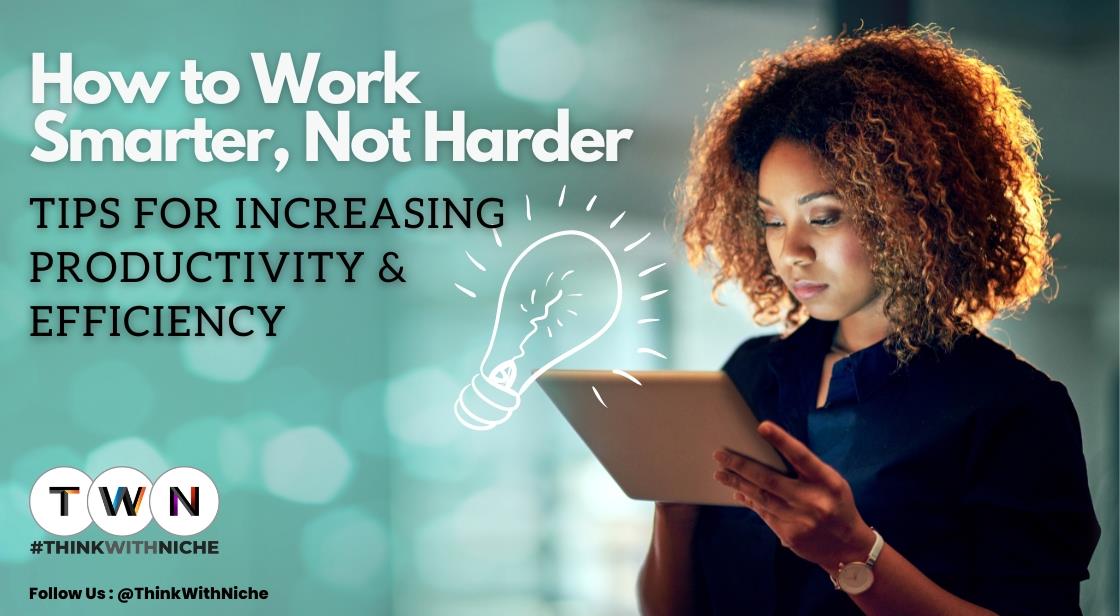How to Work Smarter, Not Harder: Tips for Increasing Productivity and Efficiency

Blog Post
In today's fast-paced world, many people believe that staying busy all the time is the key to success. However, this belief is outdated and misleading. Simply being busy doesn't necessarily mean you are being productive, and it can often lead to burnout and decreased efficiency.
Whether you work for a company or for yourself, working smarter is essential for success. If you work for a company, you need to work efficiently and effectively to keep your job and earn promotions.
If you work for yourself, your success depends entirely on your ability to work smart and grow your business.
To work smarter, there are several ideas and solutions you can implement in your daily life. By doing so, you can significantly improve your productivity and achieve better results with less time and effort.
By adopting smart work strategies, you can accomplish more in less time while minimizing stress and burnout.
In this blog, we have highlighted various tips and techniques that can help you work smarter and more effectively.
Overall, working smarter can transform your life for the better. By implementing these ideas and solutions, you can achieve better results in less time and with less stress, ultimately leading to greater success and fulfillment in both your personal and professional life.
In today's fast-paced world, everyone wants to achieve more in less time. It’s not about working longer or harder anymore; it’s about working smarter and more efficiently. Working smarter means finding ways to increase productivity and efficiency while minimizing wasted time and effort. By adopting smart work strategies, you can accomplish more in less time while minimizing stress and burnout. In this blog, we have highlighted various tips and techniques that can help you work smarter and more effectively.In this article, we will discuss some tips and strategies to help you work smarter and improve your productivity.
How to Work Smarter, Not Harder: Tips for Increasing Productivity and Efficiency
-
Set Clear Goals and Priorities:
Setting clear goals is essential to working smarter. Identify your most important tasks and focus on them first. By doing so, you'll increase your productivity and feel more accomplished. You can also create a to-do list or a daily plan to help you stay on track.
To set clear goals and priorities, it's important to understand what tasks are urgent and what tasks are important. Urgent tasks demand immediate attention, while important tasks contribute to your long-term goals. By prioritizing important tasks, you can achieve your goals more efficiently. Here are some tips to help you set clear goals and priorities:
-
Identify your long-term goals: Before you start prioritizing your tasks, identify your long-term goals. What do you want to achieve in the next month, six months, or year? Understanding your long-term goals will help you determine what tasks are most important.
-
Break down your goals into smaller tasks: Once you've identified your long-term goals, break them down into smaller, more manageable tasks. This will make it easier to prioritize your tasks and help you feel less overwhelmed.
-
Prioritize urgent and important tasks: Urgent tasks are those that require immediate attention, such as responding to emails or meeting deadlines. Important tasks are those that contribute to your long-term goals, such as working on a project or developing new skills. Prioritize urgent and important tasks first, and then move on to less urgent or less important tasks.
-
Create a to-do list or a daily plan: Creating a to-do list or a daily plan can help you stay on track and ensure that you're focusing on your most important tasks. Be sure to include deadlines and prioritize your tasks based on their importance.
By setting clear goals and priorities, you can work smarter and achieve your goals more efficiently. Remember to focus on your most important tasks, break down your goals into smaller tasks, and create a to-do list or a daily plan to help you stay on track.
-
Use Time Management Techniques:
Time management is the key to working smarter. You can use techniques like Pomodoro or Time blocking to manage your time better. These techniques involve dividing your workday into focused work periods and breaks. This helps you stay focused and reduce distractions, leading to increased productivity.
Another popular technique that can be useful for time management is the Eisenhower Matrix. It involves dividing your tasks into four categories based on their urgency and importance:
-
Important and urgent: These tasks require immediate attention and should be completed first.
-
Important but not urgent: These tasks are important but can be scheduled for a later time.
-
Urgent but not important: These tasks may seem urgent, but they can be delegated to someone else.
-
Not urgent and not important: These tasks can be eliminated or postponed.
By using the Eisenhower Matrix, you can prioritize your tasks based on their importance and urgency, which can help you manage your time more effectively.
Another time management technique that can be useful is the 80/20 rule, also known as the Pareto principle. This rule suggests that 80% of your results come from 20% of your efforts. By identifying the 20% of tasks that produce 80% of your results, you can focus on these tasks and maximize your productivity.
In addition, there are many time-tracking apps and tools available that can help you monitor your time usage and identify areas where you can improve your productivity. By tracking your time, you can also become more aware of your habits and behaviors that may be wasting your time, such as checking social media or email excessively.
Ultimately, the key to time management is to find the techniques that work best for you and to stick with them consistently. With proper time management, you can work smarter, not harder, and achieve your goals with greater efficiency and effectiveness.
-
Take Regular Breaks:
Taking regular breaks is essential to maintain your productivity levels. It’s been scientifically proven that taking short breaks can help increase your concentration and creativity. So, make sure to take a few minutes break every hour or so to recharge and refresh your mind.
In addition to taking short breaks every hour or so, it's also essential to take longer breaks throughout the day. Taking a longer break can help you reset and come back to your work with a fresh perspective. You can use your longer breaks to go for a walk, meditate, or do something that you enjoy. By taking regular breaks, you'll be able to maintain your focus, avoid burnout, and improve your overall well-being.
It's also essential to make sure that your breaks are actually breaks. Avoid checking your email or doing any work-related tasks during your break time. Instead, use this time to completely disconnect from work and recharge. This can help you avoid burnout and maintain your motivation and energy levels throughout the day.
Another tip is to try to move your body during your breaks. Sitting for long periods can lead to fatigue and decreased productivity. So, make sure to stand up, stretch, or take a short walk during your breaks to increase blood flow and oxygen to your brain. This can help you stay alert and focused when you return to your work.
Finally, make sure that you're taking breaks that work for you. Some people may prefer shorter, more frequent breaks, while others may prefer longer, less frequent breaks. Experiment with different break schedules to find what works best for you and your work style.
Also Read: Smart Financial Management in 2023- Key Mistakes To Evade And Best Practices To Follow
-
Learn to Say No:
One of the most important things you can do to work smarter is to learn to say no. Saying yes to everything can lead to burnout and decreased productivity. Learn to prioritize your time and only take on tasks that are essential and align with your goals.
Learning to say no is not about being selfish or uncooperative. It's about setting boundaries and prioritizing your time and energy. When you say no to something, you're saying yes to something else. You're saying yes to your priorities, your goals, and your well-being.
It's important to communicate clearly when you say no. Explain why you can't take on a task or project and offer an alternative solution if possible. Be assertive but respectful, and avoid making excuses or apologizing excessively. Remember that you have the right to prioritize your time and that saying no is a healthy and necessary part of working smarter.
Learning to say no can also help you build better relationships and improve your communication skills. When you communicate your boundaries and priorities clearly, people are more likely to respect them and value your time. Saying no can also help you avoid overcommitting and burning out, which can negatively impact your work and personal life.
In some cases, it may be helpful to negotiate or delegate tasks instead of saying no outright. If you can't take on a task, but you know someone else who could, consider delegating the task to them instead. This not only helps you save time but also helps others develop their skills and expertise.
Overall, learning to say no is an essential part of working smarter. It helps you prioritize your time, set boundaries, and avoid burnout. Remember that saying no is not a sign of weakness or uncooperativeness but rather a sign of self-care and effective time management.
Automate and Delegate Tasks:
Automation and delegation can help you save time and focus on more important tasks. You can use tools like Zapier or IFTTT to automate repetitive tasks, and delegate tasks to team members or virtual assistants to free up your time.
Automating and delegating tasks can be a game-changer when it comes to working smarter. Here are some more tips to help you make the most out of automation and delegation:
-
Identify tasks that can be automated or delegated: Take a look at your to-do list and identify tasks that can be automated or delegated. These tasks might include data entry, email management, or social media scheduling.
-
Choose the right tools: There are plenty of automation tools available, so it's essential to choose the right ones for your needs. Make sure to research different tools and choose the ones that fit your workflow.
-
Set up processes and workflows: Once you've identified tasks that can be automated or delegated, it's essential to set up processes and workflows to ensure they're done correctly. This can help prevent errors and make sure tasks are completed on time.
-
Delegate tasks to the right people: When delegating tasks, it's important to assign them to the right people. This can help ensure that tasks are completed correctly and efficiently.
-
Communicate clearly: When delegating tasks, it's crucial to communicate clearly with your team. Make sure they understand the task, the deadline, and any expectations you have.
By automating and delegating tasks, you can free up more time to focus on the tasks that require your attention and expertise. This can help you work smarter and achieve better results.
-
Stay Organized:
Staying organized is crucial to working smarter. You can use tools like Trello, Asana, or Evernote to keep track of your tasks, deadlines, and notes. This helps you stay on top of your work and minimize distractions.
Staying organized is not just about using the right tools, but also about developing good habits. Here are some tips to help you stay organized:
-
Clean up your workspace: A cluttered workspace can be distracting and lead to decreased productivity. Take some time to declutter your workspace and organize your files and documents.
-
Prioritize your tasks: Use a task list or a to-do list to keep track of your tasks and prioritize them based on their importance and deadlines.
-
Keep your calendar up to date: Use a digital calendar or planner to keep track of your appointments, meetings, and deadlines. Make sure to update it regularly to stay on top of your schedule.
-
Use color coding: Assign different colors to different tasks, projects, or categories to help you stay organized and easily identify important items.
-
Practice time management: Use time management techniques like Pomodoro or time blocking to manage your time more effectively and stay focused on your most important tasks.
-
Review your progress: Take some time each day or week to review your progress and make adjustments to your workflow as needed.
By staying organized, you can reduce stress, increase your productivity, and work more efficiently.
-
Avoid Multitasking:
Multitasking can reduce your productivity and increase stress levels. Instead of trying to do many things at once, focus on one task at a time. This helps you stay more focused and efficient.
It's essential to understand that the human brain is not designed for multitasking. When you try to do multiple things simultaneously, you end up switching between tasks, which leads to a decrease in productivity and an increase in errors. Instead, focus on one task at a time, and give it your undivided attention. You'll find that you'll complete tasks more quickly and with better results. Additionally, monotasking can help reduce stress and overwhelm, as you're not constantly trying to juggle multiple things at once. If you find that you're frequently interrupted or distracted, try to minimize distractions by turning off notifications, closing unnecessary tabs, and working in a quiet space.
Use Technology to Your Advantage:
Technology can help you work smarter and more efficiently. You can use tools like Grammarly to improve your writing, Slack for communication, and Dropbox to store and share files. These tools can help you save time and improve your workflow.
In addition to the tools mentioned above, there are many other technological solutions that can help you work smarter. For example, project management software like Basecamp or Jira can help you manage tasks, deadlines, and team collaboration more effectively.
Moreover, many email management tools like Boomerang or SaneBox can help you organize your inbox, prioritize important messages, and schedule emails to be sent later. This can help you avoid the distraction of constantly checking your email throughout the day.
here are some additional headings that could be used to describe how to use technology to your advantage in working smarter:
-
Project management tools: There are various project management tools available, such as Trello, Asana, and Monday.com, that can help you keep track of your tasks, deadlines, and progress. These tools allow you to collaborate with your team, assign tasks, and monitor the status of ongoing projects.
-
Communication tools: Effective communication is key to working smarter. Tools like Slack, Microsoft Teams, and Zoom can help you communicate with your team members, clients, and stakeholders more efficiently. These tools allow you to share files, hold video meetings, and send instant messages in real-time.
-
Automation tools: Automation tools such as Zapier, IFTTT, and Microsoft Power Automate can help you automate repetitive tasks and save time. These tools allow you to set up workflows that automate tasks like sending emails, creating reports, or updating spreadsheets.
-
Time-tracking tools: Time-tracking tools like Toggl, RescueTime, and Harvest can help you track how much time you spend on specific tasks. These tools allow you to identify areas where you're spending too much time and make adjustments to your workflow accordingly.
-
Online learning platforms: Continuous learning is essential to working smarter. Online learning platforms like Coursera, Udemy, and LinkedIn Learning offer a vast range of courses and training programs that can help you acquire new skills and knowledge.
-
Note-taking and organization tools: Note-taking and organization tools such as Evernote, Google Keep, and OneNote can help you keep track of your ideas, notes, and reminders. These tools allow you to capture information from multiple sources, organize it, and access it from anywhere.
-
Cloud storage and file-sharing tools: Cloud storage and file-sharing tools like Dropbox, Google Drive, and OneDrive can help you store and share files securely. These tools allow you to access your files from anywhere, collaborate with others in real-time, and maintain version control.
Focus on the Most Important Tasks First:
When you have a lot of tasks to complete, it's essential to prioritize them. Focus on the most important tasks first and complete them before moving on to less critical tasks. This helps you stay on track and ensures that you're making progress towards your goals.
Prioritizing tasks helps you to focus on what is important and ensures that you are using your time effectively. One way to prioritize tasks is by using the Eisenhower Matrix, which is a simple but effective tool that helps you determine the urgency and importance of your tasks.
-
Continuously Learn and Improve:
Finally, it's crucial to keep learning and improving to work smarter. Take courses, attend workshops, or read books to improve your skills and knowledge. This helps you stay ahead of the curve and become a more valuable asset to your team or organization.
Continuous learning and improvement are essential for professional growth and success. Here are some additional ways to learn and improve:
-
Attend conferences and seminars in your field to stay up-to-date on industry trends and best practices.
-
Seek feedback from colleagues and supervisors to identify areas for improvement and growth.
-
Join professional organizations and networking groups to connect with others in your field and learn from their experiences.
-
Engage in self-reflection and identify areas for personal and professional growth.
-
Set personal and professional development goals and track your progress towards achieving them.
-
Take on new challenges and responsibilities to stretch your skills and gain new experiences.
Here are some popular books on enhancing productivity and efficiency.
-
"Getting Things Done" by David Allen - Time management
-
"The Pomodoro Technique" by Francesco Cirillo - Time management
-
"Deep Work" by Cal Newport - Focus and concentration
-
"The 7 Habits of Highly Effective People" by Stephen Covey - Prioritization and goal-setting
-
"The One Thing" by Gary Keller and Jay Papasan - Prioritization and focus
-
"The 4-Hour Work Week" by Timothy Ferriss - Automation and delegation
-
"Atomic Habits" by James Clear - Continuous learning and improvement
Conclusion:
Working smarter, not harder, is key to achieving greater productivity and efficiency in the workplace. By following the tips outlined above, such as prioritizing tasks, taking breaks, delegating when possible, and utilizing technology, individuals can achieve their goals while reducing stress and burnout.
It is important to remember that working smarter is not a one-time fix, but a continuous process of self-reflection and improvement. By regularly reassessing one's work habits and implementing changes where necessary, individuals can optimize their workday and achieve their full potential.
In today's fast-paced and competitive work environment, it is more important than ever to work efficiently and effectively. By adopting a smarter work approach, individuals can not only increase their productivity, but also enhance their overall quality of life.
You May Like
EDITOR’S CHOICE












